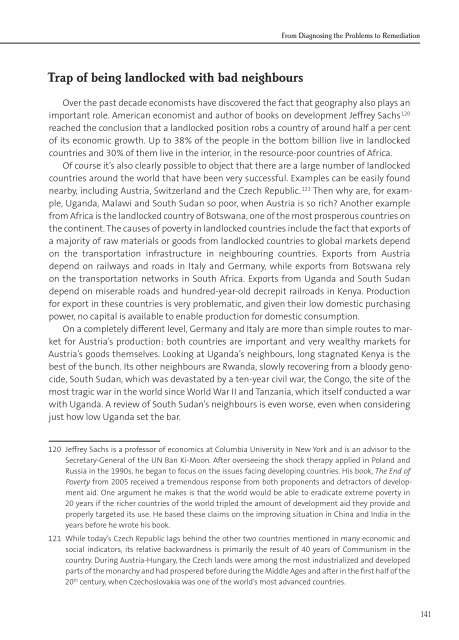Giant_and_Dwarf-FIN
Giant_and_Dwarf-FIN
Giant_and_Dwarf-FIN
Create successful ePaper yourself
Turn your PDF publications into a flip-book with our unique Google optimized e-Paper software.
From Diagnosing the Problems to RemediationTrap of being l<strong>and</strong>locked with bad neighboursOver the past decade economists have discovered the fact that geography also plays animportant role. American economist <strong>and</strong> author of books on development Jeffrey Sachs 120reached the conclusion that a l<strong>and</strong>locked position robs a country of around half a per centof its economic growth. Up to 38 % of the people in the bottom billion live in l<strong>and</strong>lockedcountries <strong>and</strong> 30 % of them live in the interior, in the resource-poor countries of Africa.Of course it’s also clearly possible to object that there are a large number of l<strong>and</strong>lockedcountries around the world that have been very successful. Examples can be easily foundnearby, including Austria, Switzerl<strong>and</strong> <strong>and</strong> the Czech Republic. 121 Then why are, for example,Ug<strong>and</strong>a, Malawi <strong>and</strong> South Sudan so poor, when Austria is so rich? Another examplefrom Africa is the l<strong>and</strong>locked country of Botswana, one of the most prosperous countries onthe continent. The causes of poverty in l<strong>and</strong>locked countries include the fact that exports ofa majority of raw materials or goods from l<strong>and</strong>locked countries to global markets dependon the transportation infrastructure in neighbouring countries. Exports from Austriadepend on railways <strong>and</strong> roads in Italy <strong>and</strong> Germany, while exports from Botswana relyon the transportation networks in South Africa. Exports from Ug<strong>and</strong>a <strong>and</strong> South Sud<strong>and</strong>epend on miserable roads <strong>and</strong> hundred-year-old decrepit railroads in Kenya. Productionfor export in these countries is very problematic, <strong>and</strong> given their low domestic purchasingpower, no capital is available to enable production for domestic consumption.On a completely different level, Germany <strong>and</strong> Italy are more than simple routes to marketfor Austria’s production: both countries are important <strong>and</strong> very wealthy markets forAustria’s goods themselves. Looking at Ug<strong>and</strong>a’s neighbours, long stagnated Kenya is thebest of the bunch. Its other neighbours are Rw<strong>and</strong>a, slowly recovering from a bloody genocide,South Sudan, which was devastated by a ten-year civil war, the Congo, the site of themost tragic war in the world since World War II <strong>and</strong> Tanzania, which itself conducted a warwith Ug<strong>and</strong>a. A review of South Sudan’s neighbours is even worse, even when consideringjust how low Ug<strong>and</strong>a set the bar.120 Jeffrey Sachs is a professor of economics at Columbia University in New York <strong>and</strong> is an advisor to theSecretary-General of the UN Ban Ki-Moon. After overseeing the shock therapy applied in Pol<strong>and</strong> <strong>and</strong>Russia in the 1990s, he began to focus on the issues facing developing countries. His book, The End ofPoverty from 2005 received a tremendous response from both proponents <strong>and</strong> detractors of developmentaid. One argument he makes is that the world would be able to eradicate extreme poverty in20 years if the richer countries of the world tripled the amount of development aid they provide <strong>and</strong>properly targeted its use. He based these claims on the improving situation in China <strong>and</strong> India in theyears before he wrote his book.121 While today’s Czech Republic lags behind the other two countries mentioned in many economic <strong>and</strong>social indicators, its relative backwardness is primarily the result of 40 years of Communism in thecountry. During Austria-Hungary, the Czech l<strong>and</strong>s were among the most industrialized <strong>and</strong> developedparts of the monarchy <strong>and</strong> had prospered before during the Middle Ages <strong>and</strong> after in the first half of the20 th century, when Czechoslovakia was one of the world’s most advanced countries.141


